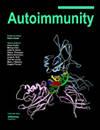LncRNA LINC00707 serves as a sponge of miR-382-5p to alleviate lipopolysaccharide (LPS)-induced WI-38 cell injury through upregulating NKAP in infantile pneumonia
IF 3.3
4区 医学
Q3 IMMUNOLOGY
引用次数: 1
Abstract
Abstract Infantile pneumonia (IP) is an acute lower respiratory infection that imposes a heavy burden on children’s health. Increasing evidence has demonstrated that long non-coding RNA (lncRNA) LINC00707 participates in the regulation of the pneumonia process. Cell proliferative ability and apoptosis were measured using Cell Counting Kit-8 (CCK-8), 5-ethynyl-2’-deoxyuridine (EdU), and flow cytometry assays. Bcl-2 related X protein (Bax), NF-kB activating protein (NKAP), p-P65, P65, p-IκBα, and IκBα protein levels were detected using western blot assay. The binding between miR-382-5p and LINC00707 or NKAP was predicted by starBase v2.0 and then verified by a dual-luciferase reporter and RNA Immunoprecipitation (RIP) assays. LINC00707 and NKAP levels were increased, and miR-382-5p was decreased in LPS-stimulated WI-38 cells. Furthermore, the silencing of LINC00707 could abrogate LPS-engendered WI-38 cell proliferation, apoptosis, and oxidative stress. LINC00707 deficiency could relieve LPS-triggered WI-38 cell damage by regulating the miR-382-5p/NKAP axis, providing a new therapeutic strategy for IP treatment.LncRNA LINC00707作为miR-382-5p的海绵,通过上调婴儿肺炎中的NKAP来减轻脂多糖(LPS)诱导的WI-38细胞损伤
摘要婴儿肺炎是一种严重影响儿童健康的急性下呼吸道感染。越来越多的证据表明,长非编码RNA(lncRNA)LINC00707参与了肺炎过程的调节。使用细胞计数试剂盒-8(CCK-8)、5-乙炔基-2'-脱氧尿苷(EdU)和流式细胞术测定细胞增殖能力和凋亡。采用蛋白质印迹法检测Bcl-2相关X蛋白(Bax)、NF-kB活化蛋白(NKAP)、p-P65、P65、p-IκBα和IκB a蛋白水平。通过starBase v2.0预测miR-382-5p与LINC00707或NKAP之间的结合,然后通过双荧光素酶报告子和RNA免疫沉淀(RIP)测定进行验证。在LPS刺激的WI-38细胞中,LINC00707和NKAP水平升高,miR-382-5p降低。此外,LINC00707的沉默可以消除LPS引起的WI-38细胞增殖、凋亡和氧化应激。LINC00707缺乏可通过调节miR-382-5p/NKAP轴来减轻LPS引发的WI-38细胞损伤,为IP治疗提供了一种新的治疗策略。
本文章由计算机程序翻译,如有差异,请以英文原文为准。
求助全文
约1分钟内获得全文
求助全文
来源期刊

Autoimmunity
医学-免疫学
CiteScore
5.70
自引率
8.60%
发文量
59
审稿时长
6-12 weeks
期刊介绍:
Autoimmunity is an international, peer reviewed journal that publishes articles on cell and molecular immunology, immunogenetics, molecular biology and autoimmunity. Current understanding of immunity and autoimmunity is being furthered by the progress in new molecular sciences that has recently been little short of spectacular. In addition to the basic elements and mechanisms of the immune system, Autoimmunity is interested in the cellular and molecular processes associated with systemic lupus erythematosus, rheumatoid arthritis, Sjogren syndrome, type I diabetes, multiple sclerosis and other systemic and organ-specific autoimmune disorders. The journal reflects the immunology areas where scientific progress is most rapid. It is a valuable tool to basic and translational researchers in cell biology, genetics and molecular biology of immunity and autoimmunity.
 求助内容:
求助内容: 应助结果提醒方式:
应助结果提醒方式:


